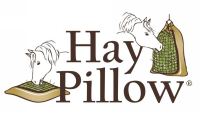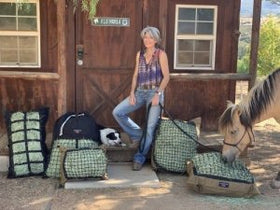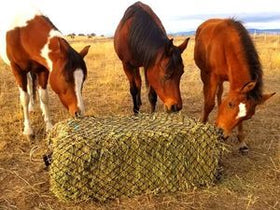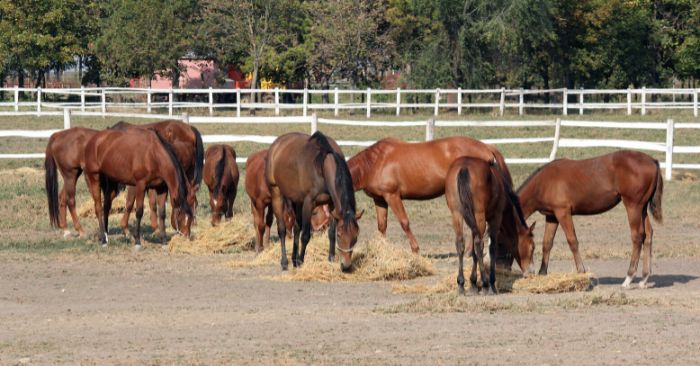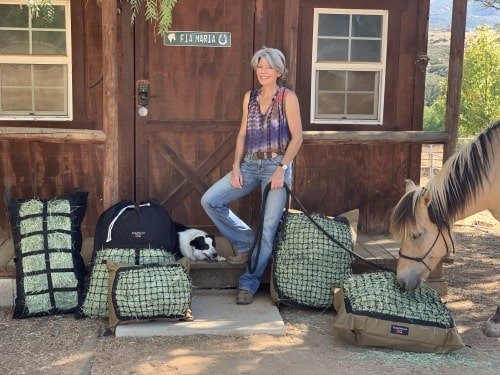Can Horses Eat More Hay Without Weight Gain? The Surprising Factors
Feeding limited amounts of highly palatable/digestible energy hay perpetuates the vicious cycle of much anticipated meals, followed by periods of time without forage. And that's not the way horses were designed to eat. So, the gastric acid discomfort builds up, boredom begins and our horses become increasingly anxious - and sometimes aggressive - come meal time.
Read on to learn how a simple shift in your approach and forage selection can 1) reduce or eliminate meal time stress and 2) give your horse more chew time and bulk (without the weight gain).

- Keeps fiber moving through the digestive tract
- Increases chew time and saliva production
- Keeps gastric acid at bay
- Reduces mental stress
Can My Horse Really Eat More or Free-Choice Without Gaining Weight?
These principles also apply if:
- Your horse is a healthy weight, but is currently fed measured meals and you want to feed more or offer a less appealing always have hay source.
- Your herd has free choice forage available, but is gaining weight and you are considering feeding meals again.
- Your horse is turned out on pasture part time (grazing muzzles are a must) and then confined/fed meals to manage his/her weight. Better understand the factors that contribute to sugar levels in pasture and hay.
- You have been advised to put your horse on a "diet" without addressing the diet itself.
Two Important Considerations for Successful Free Choice Feeding or Increasing Measured Meals
- Your Hay – Palatability, maturity, Nonstructural Carbohydrates (NSCs), digestible energy (DE) and nutrient/protein content of the forage being fed
- Your Supplements – Meeting vitamin/mineral requirements (in proper ratios) to ensure proper hormone/thyroid, immune and neurological function
The Palatability Factor & Sugar Content
While researching the topic, we discovered a study conducted by the founder of Safergrass.org, Katy Watts. The study sought to better understand the contributing factors that determine the palatability of hay and whether sugar content (WSCs) influenced the horses' hay choice.
Watts tested six different types of hay being fed in Colorado at Equi-Analytical for a complete nutrient profile. All of the hays were of good hygienic quality, without mold or dust and had bright green color.
Her discoveries?
- Aroma was the main contributing factor in the horses' preferences. They preferred hay that smelled most like fresh cut grass.
- Second to smell was texture/lower NDF fiber content. Softer hay was preferred.
- The two hays ranking lowest in palatability had the highest fiber content (NDF) with no discernible aroma.
- Sugar content (WSCs) did not influence the horses' preferences - hence the importance of testing hay despite palatability.
If you cannot test your hay for sugar content/nutrient levels, you can smell and feel the texture (maturity) by opening a bale. Coarser hay with no discernible aroma should be far less appealing. Mature grass hay (head without seed) or grass hay straw (mature grass hay with the seed head harvested) has the lowest propensity for storing sugar and starch (second to environmental conditions). To achieve adequate protein in the diet, you may need to supplement mature grass hay with limited amounts of an immature cutting of grass hay, alfalfa, or a protein rich concentrated supplement. Testing your hay is always optimum. Learn How & Where to Test Your Horse's Hay & Interpret Results
The Donkey Sanctuary recommends free choice barley straw in addition to limited grass hay or pasture as a viable option to achieve satiation and gut fill for donkeys, mules and horses.
What are Non-Structural Carbohydrates (NSC)?
NSC is a term describing the carbohydrate content of plants - defined as WSC% + Starch% or ESC% + Starch%, depending on the vet or nutritionist you are consulting. For individuals that are overweight or have Cushings Disease (PPID), Insulin Resistance (IR) or Polysaccharide Storage Myopathy (PSSM), the recommended NSC levels in the diet should be 10% or less.
According to Equi-Analytical’s common feed profile:
NSC (WSC% + Starch%) levels of grass hay in the normal range are 8.037% -17.663%.
What is NDF?
Neutral Detergent Fiber (NDF) represents the fibrous bulk of the forage and is a main contributing factor to texture/palatability. It gives the plant rigidity, enabling it to support itself as it grows. NDF digestibility in forages is directly related to leaf-to-stem ratio. The NDF in leaves is significantly more digestible than NDF in stems. More mature cuttings possess a higher stem-to-leaf ratio, resulting in lower digestibility and palatability.
According to Equi-Analytical’s common feed profile:
NDF levels of grass hay in the normal range are 55.524% - 69.319%.
Importance of Routine Dental Exams When Feeding High NDF/Mature Forage
The Digestible Energy (DE) Factor
The lower the DE, the less calories assimilated per kilogram (2.2 pounds) of hay.
According to Equi-Analytical’s common feed profile:
Horse digestible energy levels (Mcal/lb) of grass hay in the normal range is 0.811 -1.008.
5 Tips for Transitioning Successfully to Feeding More or Free- Choice Forage
1. Implement Slow Feeders
Slow feeding prevents individuals from picking through it to eat only the tastiest morsels (especially important with less palatable hay) and helps to regulate metabolism and insulin spikes.
2. Avoid Confinement
3. Supplement for Balance
All hay only diets should also include a healthy source of omegas with optimum 3-6-9 ratios (ground flaxseed or chia). Omegas are rapidly destroyed during the curing process of hay. A study at the Equine Science Society determined that feeding a 1000 pound horse 4.5 ounces of flax seed resulted in blood levels of omega-3 comparable to horses on pasture.
4. Feed Loose Salt to Avoid Dehydration & Provide Clean Water
5. Introduce New Forages Slowly
When your herd has adapted to the new forage, feed the less palatable hay separately or exclusively to achieve optimum results.
Concluding Remarks
- To the best of my knowledge, the palatability concept in feeding free choice or increasing meal sizes is rarely explored or written about, but certainly worth considering. Always consult your veterinarian when making any changes in your feeding program.
- Domestication of grazing animals designed to forage 24/7 on a variety of plants, brush and trees certainly presents challenges. In nature, their activities consist of walking and grazing, interacting with herd mates and periods of rest.
- On the other hand: confinement, feeding limited amounts of palatable, highly digestible forage and isolation can cause obesity, anxiety-related stress, vices and boredom – especially when they suppress a horse's natural instincts.
- Providing appropriate free choice forage, freedom of movement and a species appropriate environment will provide your herd with the basics of their natural lifestyle and instincts - despite domestication.
Helpful Resources Directly Related to This Article
- Are You a Prisoner of Feeding? Here's How I Broke Free
- How & Where to Test Your Horse's Hay & Interpret Results
- How to Introduce & Incorporate Free-Choice Forage: An Action Plan
- 9 Benefits of Slow Feeding Horses - Get Slow Feed Savvy
- Equine Gastric Acid - 12 Facts You May Not Know
- Equine Gut Health - The Need for Feed
- Sand Colic - The Surprising (Simple) Cure & Prevention
- Why Horses Need Salt & Why Salt Blocks Are Not Enough
- A Safer Always Have Hay Source – Mature Grass Hay
- Sugar Content of Pasture & Hay: Q & A with Katy Watts, Founder of Safergrass.org
References:
- Watts, K. (2011) Does Sugar Concentration Determine Hay Preference by Horses? Retrieved from: https://www.safergrass.org/s/PalatabilityFinal.pdf
- Equi-Analytical Common Feed Profiles. Retrieved from https://equi-analytical.com/common-feed-profiles/interactive-common-feed-profile/
- Equi-Analytical Glossary of Nutrient Terms. Retrieved from https://equi-analytical.com/resources/glossary-of-nutrient-terms/
- Hoffman, P. C., Lundberg K.M., Bauman L.M. and Shaver, R.D. (2003) The Effect of Maturity on NDF Digestibility. Retrieved from https://fyi.extension.wisc.edu/forage/the-effect-of-maturity-on-ndf-digestibility/
- Freeman, D. W. (2020, January 20) Nutrient Requirements for Horses. Retrieved from https://horses.extension.org/nutrient-requirements-for-horses/
- Kellon, E. (2021, May 24) Flax To Mimic Pasture. Retrieved from https://drkhorsesense.wordpress.com/2021/05/24/flax-to-mimic-pasture/
